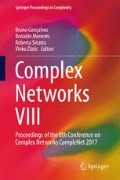Abstract
Social media often reveals a complex interplay between positive and negative ties. Yet, the origin of such complex patterns of interaction remains largely elusive. In this paper we study how third parties may sway our perception of others. Our model relies on the analysis of all triadic relations taking into account the influence and relations with common friends, through large-scale simulations. We show that a simple peer-influence mechanism, based on balance theory of social sciences, is able to promptly increase the degree of balance of a signed network—with balance defined as the fraction of positive cycles—irrespectively of the network we start from. Additionally, our results indicate that the tendency towards a balanced state also depends on the network connectivity and on the initial distribution of signs.
Access this chapter
Tax calculation will be finalised at checkout
Purchases are for personal use only
References
Harary, F.: On the notion of balance of a signed graph. Mich. Math. J. 2, 143–146 (1954)
Cartwright, D., Harary, F.: Structural Balance: a Generalization of Heider’s theory. Psychol. Rev. 63, 277–292 (1956)
Davis, J.A.: Clustering and structural balance in graphs. Hum. Relat. 20, 181–187 (1967)
Hummon, N.P., Doreian, P.: Some dynamics of social balance processes: bringing Heider back into balance theory. Soc. Netw. 25(1), 17–49 (2003)
Leskovec, J., Huttenlocher, D., Kleinberg, J.: Signed networks in social media. In: 28th ACM Conference on Human Factors in Computing Systems (CHI) (2010)
Leskovec, J., Huttenlocher, D., Kleinberg, J.: Predicting positive and negative links in online social networks. In: 28th ACM Conference on Human Factors in Computing Systems (CHI) (2010)
Facchetti, G., Iacono, G., Altafini, C.: Computing global structural balance in large-scale signed social networks. Proc. Natl. Acad. Sci. USA 108, 20953–20958 (2011)
Estrada, E., Benzi, M.: Are social networks really balanced? arXiv:1406.2132 [physics.soc-ph] (2014)
Skyrms, B.: The Stag Hunt and the Evolution of Social Structure. Cambridge University Press (2004)
Kossinets, G., Watts, D.J.: Empirical analysis of an evolving social network. Science 311(5757), 88–90 (2006)
Santos, F.C., Pacheco, J.M., Lenaerts, T.: Cooperation prevails when individuals adjust their social ties. PLoS Comput. Biol. 2(10), e140 (2006)
Gross, T., Blasius, B.: Adaptive coevolutionary networks: a review. J. R. Soc. Interface 5(20), 259–271 (2008)
Barabási, A.-L.: Network Science. Cambridge University Press (2016)
Antal, T., Krapivsky, P.L., Redner, S.: Dynamics of social balance on networks. Phys. Rev. Lett. 72, 036121 (2005)
van de Rijt, A.: The micro-macro link for the theory of structural balance. J. Math. Sociol. 35, 94–113 (2011)
Dorogovtsev, S.N.: Lectures on Complex Networks. Oxford University Press, Oxford (2010)
Christakis, N.A., Fowler, J.H.: The spread of obesity in a large social network over 32 years. N. Engl. J. Med. 357(4), 370–379 (2007)
Christakis, N.A., Fowler, J.H.: The collective dynamics of smoking in a large social network. N. Engl. J. Med. 358(21), 2249–2258 (2008)
Pinheiro, F.L., Santos, M.D., Santos, F.C., Pacheco, J.M.: Origin of peer influence in social networks. Phys. Rev. Lett. 112(9), 098702 (2014)
Pastor-Satorras, R., Castellano, C., Van Mieghem, P., Vespignani, A.: Epidemic processes in complex networks. Rev. Mod. Phys. 87(3), 925 (2015)
Santos, F.C., Pacheco, J.M., Lenaerts, T.: Evolutionary dynamics of social dilemmas in structured heterogeneous populations. Proc. Natl. Acad. Sci. USA 103(9), 3490–3494 (2006)
Santos, F.C., Santos, M.D., Pacheco, J.M.: Social diversity promotes the emergence of cooperation in public goods games. Nature 454(7201), 213–216 (2008)
Szabó, G., Fath, G.: Evolutionary games on graphs. Phys. Rep. 446(4), 97–216 (2007)
Rand, D.G., Nowak, M.A., Fowler, J.H., Christakis, N.A.: Static network structure can stabilize human cooperation. Proc. Natl. Acad. Sci. USA 111(48), 17093–17098 (2014)
Castellano, C., Fortunato, S., Loreto, V.: Statistical physics of social dynamics. Rev. Mod. Phys. 81(2), 591 (2009)
Barabasi, A.-L.: The origin of bursts and heavy tails in human dynamics. Nature 435(7039), 207–211 (2005)
Onnela, J.-P., et al.: Structure and tie strengths in mobile communication networks. Proc. Natl. Acad. Sci. USA 104(18), 7332–7336 (2007)
Acknowledgements
This work was partly supported by national funds through Universidade de Lisboa and FCT—Fundação para a Ciência e Tecnologia, under projects TUBITAK/0004/2014, PTDC/EEI-SII/5081/2014, PTDC/EEI-SII/1973/2014, PTDC/MAT/STA/335 8/2014 and UID/CEC/50021/2013.
Author information
Authors and Affiliations
Corresponding author
Editor information
Editors and Affiliations
Rights and permissions
Copyright information
© 2017 Springer International Publishing AG
About this paper
Cite this paper
Teixeira, A.S., Santos, F.C., Francisco, A.P. (2017). Emergence of Social Balance in Signed Networks. In: Gonçalves, B., Menezes, R., Sinatra, R., Zlatic, V. (eds) Complex Networks VIII. CompleNet 2017. Springer Proceedings in Complexity. Springer, Cham. https://doi.org/10.1007/978-3-319-54241-6_16
Download citation
DOI: https://doi.org/10.1007/978-3-319-54241-6_16
Published:
Publisher Name: Springer, Cham
Print ISBN: 978-3-319-54240-9
Online ISBN: 978-3-319-54241-6
eBook Packages: Physics and AstronomyPhysics and Astronomy (R0)

